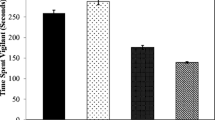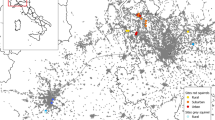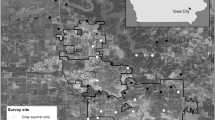Abstract
Increased density, increased intraspecific aggression, and a reduced fear of humans have been suggested as the more observable and frequently described characteristics of wildlife species undergoing synurbization, the process of becoming urbanized. The relationship among these variables and how they may be related to environmental variables that change with urbanization is poorly understood. In this paper we explore the relationship between density, intraspecific aggression, and reduced fear of humans in urban populations of gray squirrel. In the summer and fall of 2003 and 2004, we studied a park with a documented high density of gray squirrels, Lafayette Park, Washington, DC, and six urban parks in Baltimore, MD with unknown squirrel densities. We used linear regression (SAS Institute, SAS/STAT user’s guide. SAS Institute, Cary, NC, 2005) to determine if there was a relationship (P < 0.05) between squirrel density and intraspecific aggression, squirrel density and reduced fear of humans (wariness), and squirrel density and habitat suitability. We found a positive association between density and intraspecific aggression (R 2 = 0.81, P < 0.00). A negative relationship between density and wariness (\(R_{{\text{adj}}}^2 = 0.71\), P < 0.00). However, no relationship was evident between habitat suitability and squirrel density (\(R_{{\text{adj}}}^2 = - 0.50\), P = 0.437).


Similar content being viewed by others
References
Bowers MA, Breland B (1996) Foraging of gray squirrels on an urban–rural gradient: use of the GUD to assess anthropogenic impact. Ecol Appl 6:1135–1142
Burger J (2001) The behavioral response of basking Northern water (Nerodia sipedon) and Eastern garter (Thamnophis sirtalis) snakes to pedestrians in a New Jersey park. Urban Ecosyst 5:119–129
Cooke AS (1980) Observations on how close certain passerine species will tolerate an approaching human in rural and suburban areas. Biol Conserv 18:85–88
Ditchkoff S, Saalfeld S, Gibson C (2006) Animal behavior in urban ecosystems: modifications due to human-induced stress. Urban Ecoysyst 9:5–12
Flyger VF (1955) Implications of social behavior in gray squirrel management. Trans North Am Wildl Nat Resour Conf 20:381–389
Flyger VF (1959) A comparison of methods for estimating squirrel populations. J Wildl Manage 23:220–223
Flyger VF (1970) Urban gray squirrels—problems, management, and comparisons with forest populations. Trans Northeast Fish Wildl Conf 27:107–113
Flyger VF (1974) Tree squirrels in urbanizing environments. In: Noyes JH, Progulske DR (eds) Wildlife in an urbanizing environment. Univ. Mass. Coop. Ext. Serv., Amherst, MA, pp 235–248
Gliwicz J, Goszczynski J, Luniak M (1994) Characteristic features of animal populations under synurbization—the case of the Blackbird and of the Striped Field Mouse. Memorabilia Zool 49:237–244
Gustafson EJ, VanDruff LW (1990) Behavior of black and gray morphs of Sciurus carolinensis in an urban environment. Am Midl Nat 123:186–192
Hadidian J, Manski D, Flyger V, Cox C, Hodge G (1988) Urban gray squirrel damage and population management: a case history. Proceedings of the Third Eastern Wildlife Damage Control Conference, pp 219–227
Hein EW (1997) Demonstration of line transect methodologies to estimate urban gray squirrel density. Environ Manage 21:943–947
Kinzig AP, Warren P, Chris M, Hope D, Katti M (2005) The effects of human socioeconomic status and cultural characteristics on urban patterns of biodiversity. Ecology and Society 10(23). Available at http://www.ecologyandsociety.org/vol10/iss1/art23
Koprowski JL (1994) Sciurus carolinensis. Mamm Species 480:1–9
Manski DA, VanDruff LW, Flyger V (1980) Activities of gray squirrels and people in a downtown Washington, D.C. park: management implications. Trans North Am Wildl Nat Resour Conf 46:439–454
McPherson EG, Nilon C (1987) A habitat suitability index model for gray squirrel in an urban cemetery. Lands J 6:21–30
Merwe M, Brown J, Jackson M (2005) The coexistence of Fox (Sciurus niger) and gray (S. carolinensis) squirrels in the Chicago metropolitan area. Urban Ecosyst 8:335–347
Nilon CH, Berkowitz AR, Hollweg KS (1999) Understanding urban ecosystems: a new frontier for science and education. Urban Ecosyst 3:3–4
Olszweski GJ (1964) Lafayette Park. Nat. Cap. Reg. Hist. No. 1. USDI, Nat. Park Serv
SAS Institute (2005) SAS/STAT user’s guide. SAS Institute, Cary, NC
Schwartz CW, Schwartz ER (1981) The wild mammals of Missouri. University of Missouri Press, Columbia
Shargo ES (1988) Home range, movements, and activity patterns of coyotes (Canis latrans) in Los Angeles suburbs. Ph.D. Dissertation, University of California, Los Angeles
Steele MA, Koprowski JL (2001) North American tree squirrels. Smithsonian Institution Press, Washington
Smith H, Engeman R (2002) An extraordinary raccoon, Procyon lotor, density at an urban park. Can Field Nat 116(4):636–639
Thompson DC, Thompson PS (1980) Food habits and caching behavior of urban grey squirrels. Can J Zool 58:701–710
Warren P, Tripler C, Bolger D, Faeth S, Huntly N, Lepczyk C, Meyer J, Parker T, Shochat E, Walker J (2006) Urban food webs: predators, prey, and the people who feed them. Bull Ecol Soc Am 87(4):387–393
Williamson RD (1983) Identification of urban habitat components which affect eastern gray squirrel abundance. Urban Ecol 7:345–356
Acknowledgments
This project was conducted as part of the Baltimore Ecosystem Study (BES) and supported by the National Science Foundation Long-term Ecological Research program (grant number DEB 0423476). We thank the researchers associated with BES and the USDA Forest Service Northeastern Research Station for the technical support, research staff time, equipment, and in kind services. In addition, we thank the Parks and People Foundation of Baltimore City for their assistance with the geographical and land use data. We also thank the Wildlife Initiative Program at Lincoln University Missouri for providing students to aid in the collection of field data.
Author information
Authors and Affiliations
Corresponding author
Rights and permissions
About this article
Cite this article
Parker, T.S., Nilon, C.H. Gray squirrel density, habitat suitability, and behavior in urban parks. Urban Ecosyst 11, 243–255 (2008). https://doi.org/10.1007/s11252-008-0060-0
Received:
Accepted:
Published:
Issue Date:
DOI: https://doi.org/10.1007/s11252-008-0060-0




